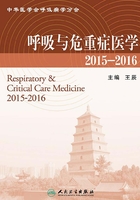
上QQ阅读APP看书,第一时间看更新
6 吸入糖皮质激素和肺部感染
张静
吸入糖皮质激素(inhaled corticosteroid,ICS)是哮喘和慢性阻塞性肺疾病治疗的重要组成部分。随着数据的积累,在一些研究中观察到长期使用ICS和细菌或分枝杆菌肺部感染罹患风险升高相关 [1-6],本文将综述这方面的进展。
一、肺炎
1.慢阻肺中的研究
(1)长期使用ICS者肺炎风险轻微上升,但研究结果不尽一致:
Cochrane数据库最新(2014)荟萃分析共纳入43项研究,其中21 247例吸入氟替卡松的慢阻肺患者肺炎的风险略有增加,比值比(OR)为1.78(95%CI 1.5~2.12);10 150例吸入布地奈德的患者中OR值为1.62(95%CI 1.0~2.62) [7];相当于每1000例吸入氟替卡松18个月的患者将多出现18例肺炎,或每1000例吸入布地奈德9个月患者将会多发生6例肺炎。值得指出的是,在入选的所有单项研究中,肺炎都是少见的,而且往往肺炎的诊断缺乏明确定义,并且肺炎往往不是研究所设计的观察终点。
在一项纳入7项临床试验、共7042例慢阻肺患者的研究中,有3801例吸入布地奈德,这些患者合并肺炎的风险并未升高 [8]。
另一项回顾性研究观察了不同的ICS/LABA联合治疗的肺炎的相对危险性。在2734例接受氟替卡松/沙美特罗或布地奈德/福莫特罗治疗的慢阻肺患者中,ICS治疗患者肺炎RR(rate ratio)为1.73(95%CI1.57~1.90)、住院的RR为1.74(95%CI 1.56~1.94) [9]。
在一项较早的在加拿大魁北克省的患者人群中进行的巢式病例对照研究中,应用ICS的慢阻肺患者因肺炎住院的风险上升 [4]。该项研究分析了1988年至2003年之间175 906例慢阻肺患者,其中23 942人在随访期间因肺炎住院。当前使用ICS对于因肺炎住院的RR为1.70(95%CI 1.63~1.77)。因肺炎住院的风险在ICS高剂量组(相当于氟替卡松1000μg/d以上)更明显(RR 2.25;95%CI,2.07~2.44)。
(2)ICS应用并不增加肺炎死亡率和全因死亡率:
荟萃分析显示ICS/长效β2受体激动剂(LABA)治疗患者中,肺炎相关死亡率以及总死亡率都未见显著上升 [7]。
最近一项美国研究中分析了6353例慢阻肺和肺炎住院治疗患者的死亡率,发现规则使用ICS的患者和非ICS使用者相比,30天和90天死亡率均无上升 [10]。
前述加拿大研究结果提示当前使用ICS对于因肺炎住院30天死亡的RR为1.53(95%CI,1.30~1.80);而全因死亡率在ICS组和非ICS组无显著差异(分别为7.4和8.2%) [4]。
为了明确ICS治疗和老年慢阻肺患者住院肺炎的死亡率之间的关系,Malo等 [11]在64岁及以上慢阻肺住院肺炎患者中评估ICS暴露与死亡率之间的关联。共有6353例肺炎同时曾被诊断为慢阻肺的患者,其中38%正在接受ICS治疗。30天和90天死亡率分别为9%和16%。通过回归分析,ICS治疗与30天(OR 0.80,95%CI 0.75~0.86)和90天死亡率(OR0.76,95%CI 0.70~0.83)较低相关,这和加拿大研究的结果恰恰相反。在一项663例社区获得性肺炎的队列研究中,128例患者在发病前应用ICS;这项研究同样观察到应用ICS患者30天死亡率和90天死亡率均显著低于非ICS组,并且血清肿瘤坏死因子-α和白介素-6水平较非ICS使用者更低 [12]。
因此,总体上,尽管肺炎的风险增加,但是肺炎相关的死亡风险和总死亡率并未增加 [13]。
(3)不同类型的ICS之间的比较:
Cochrane数据库荟萃分析进行了氟替卡松和布地奈德的间接比较,显示严重不良事件或死亡率两者间都没有显著差异 [7]。
在前述回顾性研究中,氟替卡松/沙美特罗治疗的患者肺炎相关死亡率(97例死亡)高于布地奈德/福莫特罗组(52例死亡,风险比1.76,95%CI 1.22~2.53),但全因死亡率没有差异 [8]。这项研究的缺陷在于回顾性设计,缺乏确切的疾病严重度评价,以及氟替卡松/沙美特罗组基线使用抗生素更多,因此对于研究结论的评价应持谨慎态度。
2.哮喘中的研究
回顾性分析14 993例入选吸入布地奈德或安慰剂临床试验的哮喘患者,发现肺炎的风险没有增加 [14]。另外,ICS的剂量或与肺炎风险有关。一项病例对照研究发现,吸入的最高剂量(≥1000μg/d)糖皮质激素的哮喘患者和那些没有在过去90天内使用过ICS的患者比较,前者肺炎或下呼吸道感染风险上升(2.04,95%CI 1.59~2.64) [15]。
二、结核病
在一项病例对照研究中,共纳入超过40万哮喘或慢阻肺患者,共发生564例肺结核,肺结核的风险在ICS患者轻微升高(RR 1.26,95%CI 1.18~1.56),特别是使用的剂量相当于氟替卡松1000μg/d或以上者风险更高(RR 1.97,95%CI 1.18~3.3) [16]。但是,在这项研究中,不能完全排除吸烟、社会经济地位、或使用抑制细胞色素P450 3A4活性的药物等混杂因素的影响。
在一项队列研究中,慢阻肺患者应用ICS是肺结核的独立危险因素:在影像学检查提示存在肺结核病史的患者中肺结核再发的HR为24.94(95%CI 3.09~201.36),而在先前胸片正常的患者中肺结核的HR为9.08(95%CI 1.01~81.43) [17]。然而,这项研究样本量较小,因此可信度相对较低。
三、非结核性分枝杆菌感染
有一项独立的研究提出,在慢阻肺患者中ICS 治疗可能增加非结核分枝杆菌(NTM)疾病的风险。在一个基于人群的病例对照研究中,曾经接受过ICS治疗的慢阻肺患者罹患NTM疾病的比值比(OR)为19.6(95%CI9.7~39.6),相比之下,未接受ICS治疗者的OR为7.6(95%CI3.4~16.8) [18]。但是,NTM的绝对风险低,加之这项研究的回顾性设计也限制了其可信度。另外,这项研究的另一个偏移因素在于,NTM疾病的早期症状可能已被错误归因于慢阻肺。
综上所述,即便长期吸入ICS将轻微增加肺部感染风险(主要是在慢阻肺患者中),但是考虑到ICS/LABA在慢阻肺治疗中对于死亡率、急性加重风险、生活质量方面的确切益处以及在控制哮喘中的核心地位,仍主张在具备使用ICS指征的患者中规则应用该药物 [19];但是充分评估ICS的受益与肺部感染风险升高之间的平衡是非常有必要的 [20,21]。同时,研究ICS增加肺部感染风险的机制 [1]、筛选ICS吸入后肺部感染高风险的预测指标将有助于推动ICS在慢性气道疾病中的个体化应用。
参考文献
1. Finney L,Berry M,Singanayagam A,et al. Inhaled corticosteroids and pneumonia in chronic obstructive pulmonary disease. The Lancet Respiratory medicine,2014,2(11):919-932.
2. DiSantostefano RL,Sampson T,Le HV,et al. Risk of pneumonia with inhaled corticosteroid versus long-acting bronchodilator regimens in chronic obstructive pulmonary disease:a new-user cohort study.PLoS One,2014,9(5):e97149.
3. Singh S,Loke YK. Risk of pneumonia associated with long-term use of inhaled corticosteroids in chronic obstructive pulmonary disease:a critical review and update. Curr Opin Pulm Med,2010,16(2):118-122.
4. Ernst P,Gonzalez AV,Brassard P,et al. Inhaled corticosteroid use in chronic obstructive pulmonary disease and the risk of hospitalization for pneumonia. Am J Respir Crit Care Med,2007,176(2):162-166.
5. Woodhead M. Inhaled corticosteroids cause pneumonia ...or do they?Am J Respir Crit Care Med,2007,176(2):111-112.
6. Drummond MB,Dasenbrook EC,Pitz MW,et al. Inhaled corticosteroids in patients with stable chronic obstructive pulmonary disease:a systematic review and meta-analysis. JAMA,2008,300(20):2407-2416.
7. Kew KM,Seniukovich A. Inhaled steroids and risk of pneumonia for chronic obstructive pulmonary disease. Cochrane Database Syst Rev,2014,3:CD010115.
8. Sin DD,Tashkin D,Zhang X,et al. Budesonide and the risk of pneumonia:a meta-analysis of individual patient data. Lancet,2009,374(9691):712-719.
9. Janson C,Larsson K,Lisspers KH,et al. Pneumonia and pneumonia related mortality in patients with COPD treated with fixed combinations of inhaled corticosteroid and long acting beta2 agonist:observational matched cohort study(PATHOS). BMJ,2013,346:f3306.
10. Festic E,Scanlon PD. Incident pneumonia and mortality in patients with chronic obstructive pulmonary disease. A double effect of inhaled corticosteroids? Am J Respir Crit Care Med,2015,191(2):141-148.
11. Malo de Molina R,Mortensen EM,Restrepo MI,et al. Inhaled corticosteroid use is associated with lower mortality for subjects with COPD and hospitalised with pneumonia. Eur Respir J,2010,36(4):751-757.
12. Ferrer M,Torres A,Martinez R,et al. Inhaled corticosteroids and systemic inflammatory response in community-acquired pneumonia:a prospective clinical study. Respirology,2014,19(6):929-935.
13. Singanayagam A,Chalmers JD,Hill AT. Inhaled corticosteroids and risk of pneumonia:evidence for and against the proposed association. QJM,2010,103(6):379-385.
14. O'Byrne PM,Pedersen S,Carlsson LG,et al. Risks of pneumonia in patients with asthma taking inhaled corticosteroids. Am J Respir Crit Care Med,2011,183(5):589-595.
15. McKeever T,Harrison TW,Hubbard R,et al. Inhaled corticosteroids and the risk of pneumonia in people with asthma:a case-control study. Chest,2013,144(6):1788-1794.
16. Brassard P,Suissa S,Kezouh A,et al. Inhaled corticosteroids and risk of tuberculosis in patients with respiratory diseases. Am J Respir Crit Care Med,2011,183(5):675-678.
17. Kim JH,Park JS,Kim KH,et al. Inhaled corticosteroid is associated with an increased risk of TB in patients with COPD. Chest,2013,143(4):1018-1024.
18. Andrejak C,Nielsen R,Thomsen VO,et al. Chronic respiratory disease,inhaled corticosteroids and risk of non-tuberculous mycobacteriosis. Thorax,2013,68(3):256-262.
19. Iannella H,Luna C,Waterer G. Inhaled corticosteroids and the increased risk of pneumonia:what's new? A 2015 updated review.Ther Adv Respir Dis,2016.
20. Price D,Yawn B,Brusselle G,et al. Risk-to-benefit ratio of inhaled corticosteroids in patients with COPD. Prim Care Respir J,2013,22(1):92-100.
21. Singh S,Loke YK. An overview of the benefits and drawbacks of inhaled corticosteroids in chronic obstructive pulmonary disease.Int J Chron Obstruct Pulmon Dis,2010,5:189-195.